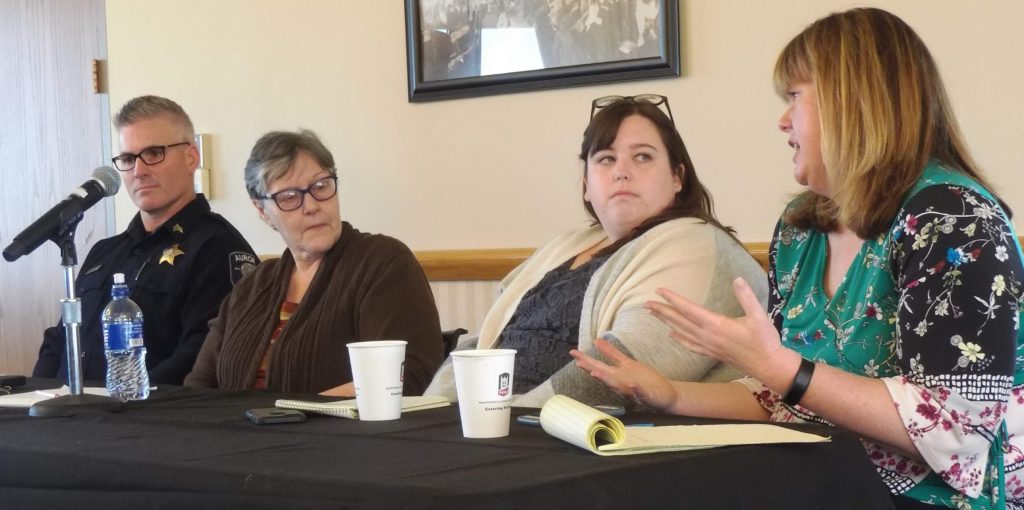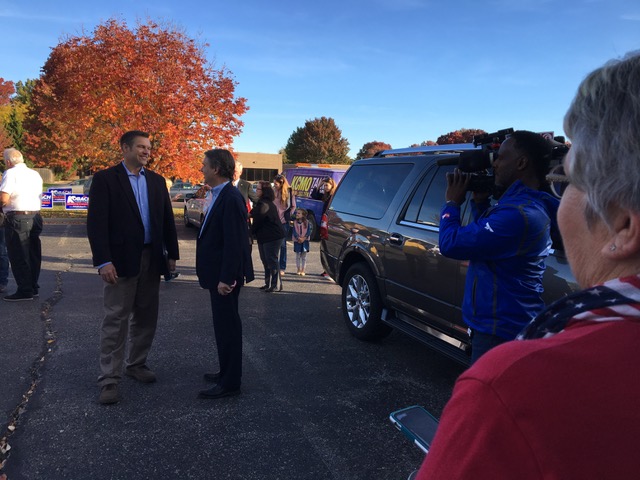How journalists can cover mass shootings with compassion, respect and still ask tough questions
Reporter Megan Jones of the Aurora Beacon-News was one of the first reporters on the scene of a mass shooting in Aurora in February. She had just finished interviewing a mother whose son was shot the month before when she heard an ambulance scream past on its way to the Henry Pratt Co. manufacturing plant where five people had been killed. Chicago Tribune reporter Stacy St. Clair was working from home one town over and headed to Pratt after seeing Jones’ tweet on the active shooter.
“We’re sister papers, and we work as a team,” said St. Clair, who had covered another mass shooting on Valentine’s Day 2008 at Northern Illinois University. Six people died that day.
It’s important for journalists to come together to discuss strategy and news judgment, said James Fuller, senior writer at the Daily Herald in Arlington Heights and president of the Northern Illinois Newspaper Association, based at the DeKalb campus. Widespread layoffs have drained newsrooms of veteran reporters who have been through this kind of breaking news coverage, he said.

“Part of the conversation was editors realizing on the day of the Pratt shooting that many of the folks they had on staff at the time of that NIU shooting were gone,” Fuller said. “So we thought it would be a good idea to pull together folks who covered the Pratt shooting, or experienced it, for some reflection on what went well and what didn’t go so well.”
Jones and St. Clair were two of the panelists at a seminar in April at Northern Illinois University. Other panelists were Anita Lewis, a 41-year Pratt employee and Aurora Police Sgt. Bill Rowley, whose first day on the job as the department’s public information officer was only days earlier.
“We realized we were not at all prepared for this. We had no active-shooter training,” Lewis said, adding she learned what was happening inside her own workplace from ABC News.
Rowley, who has hostage negotiation training, headed to the Pratt building that day. “Two who were shot were in my squad. Chief (Kristen) Ziman turned to me and told me to get back to the station, ‘The place is crawling with media, you need to handle this and tell them where they need to stage.’ I didn’t know the lingo. I knew APA in grad school, not AP. I had to find a way to get the media in one spot. My voicemail filled up in 12 minutes. I was not on Twitter until that day.”
Rowley said he was upfront about his lack of experience in dealing with the media. “It was important to get as much of the message out as we can. We did the best we could,” he said.
One of the hardest parts of the day was not only dealing with victims’ families but dealing with the national media, both Rowley and Lewis said.
“When I heard they camped outside of families’ homes and made their way in posing as pizza delivery people, I was furious,” Rowley said. “Local media was very understanding and helpful in a crisis. They wanted their story and they knew what we were facing.”
Rowley said he used the police department’s Facebook page but admitted he wished he had been more prepared on the front end. “It’s police first, media second.”
A lifelong Kane County resident, Lewis said local news reporters were respectful and others “were looking for the next big headline. I gave two interviews, to the Kane County Chronicle and the Aurora-Beacon News. The national media was horrible.”
Lewis questioned when Pratt would stop making the front page. “It’s really hard to heal. There was a coroner’s report a few days ago. It’s very hard for people to heal when you see on the front page that someone was shot five times in the head – sorry, those are my friends you’re talking about here. How long do you keep this in the public eye?”
She said the company’s owners put employees under a press gag order for the first 72 hours. “I didn’t talk to anyone I didn’t have a relationship with. It’s up to the police and FBI to find out what happened. It’s not up to me.”
But journalists also have a job to do.
“We’re all going to knock on doors,” St. Clair said. “No one wants to cause more harm. Are there more respectful ways to do this?”
Lewis said she wished reporters would let police and officials handle it in the beginning. “Call me after 24 hours. Say, ‘I know you’re an employee and you lost some friends.’ It’s hard on family members. Gary’s (Martin, the gunman who killed five, wounded six and was killed by police) family literally went through hell the first few days. It was hard on them. That’s their son, an uncle who played with their kids, a loner, yes, but still, that’s their son.”
She recalled those who attended the prayer vigil for the victims being asked by members of the national media, “Who are you, why are you there?”
Biesk countered that mass shootings are a national story. “Presidential debates and campaigns discuss them. There can’t be this notion that something tragic happens and CNN isn’t going to cover it.”
Lewis suggested national outlets rely on the trusted local affiliates to get the story, similar to how hurricanes are covered.
St. Clair noted reporters “get really nervous when you’re doing this and sometimes what you say comes out wrong. They feel the pressure of the job and the sorrow and loss of the family.”
“I covered the shooting here at NIU and after 20 years it never gets easier,” St. Clair said. “No reporter enjoys that. I tell the victim’s family that yes, there will be a story in the paper tomorrow about how their father died. I want to explain how he lived and his loss to the community,” she said, referring to Vicente Juarez’s neighbors recalling “great stories of leading his subdivision’s war against dandelions.” After Juarez’s family saw the story online, relatives contacted St. Clair and were ready to talk.
Rowley was asked from a police perspective about the dumbest things that journalists did in this incident.
“The pizza delivery infuriated me. And there was another reporter who wanted me to know that she was a cop’s wife. She sends me emails once a week and ‘cop’s wife’ is in the subject. Let me tell you, if I get an email from the national media I’ll delete it, I don’t care,” Rowley said. “The media wants immediate and direct contact with officers but there were questions I couldn’t answer. The FOID card issue was with the state police, it’s not within our scope,” he said, referring to the revelation that Illinois State Police revoked Martin’s FOID card and rejected his concealed carry application but he still possessed a gun.
Rowley said the police department learned valuable lessons from that day. “Since Pratt, we’ve had meetings in the city and training set up through Homeland Security, training with fire and police department and share it with Naperville,” he said of the neighboring town. “Next time this happens it won’t be someone like me who’s in the fight. I’ll be doing my job somewhere else in the middle of it.” Rowley said a new Aurora PIO will be named.
Anne Halston, editor of three regional newspapers owned by the Chicago Tribune,was off work the day of the shootings at Pratt. She said saw on her official alert subscription service that there was an active shooter at Aurora University, not at a business in the industrial area. She said because the Aurora scanner system is encrypted it’s hard to get information.
Rowley recommended signing up for Everbridge or Nixle for alerts from local public safety agencies. “You’ll get cell phone alerts to your phone. We use Everbridge internally and we used it on a limited basis for Pratt. We now use Nixle and someone will be able to send out an alert.”
He outlined how the public can use Nixle to alert the police about incidents. “If you see a fight, shoot the video and upload it a Cloud service and we’ll know where to go.”
Rowley was asked if he thought media outlets should identify the gunman. “We said his name – one time – in the beginning. We don’t want it on our conscience that we encouraged someone. We’re not going to take up that flag. In law enforcement, this is a trend.”
Lewis saw it another way. “For me, his name was not glorifying what he did. I had known him for 15 years. His name is part of the story. His name will come out because of his record. We’re being naïve if we don’t think there are dark people in our world.”
Jones saw this case as different from those with random mass shooters. “This is a peculiar case. He had a relationship with these employees,” she said of the gunman. She mentioned the paper’s columnist, Denise Crosby, was going to write a eulogy column on how Martin was a hard worker, but ultimately decided not to write the story. “He had a record and history and we ran his mugshot the first couple of days, but let’s not keep running it,” Jones said. It was also the paper’s policy to refer to Martin as “the shooter.”
Lewis talked about an employee assistance meeting at Pratt in which someone said: “Let’s talk about the elephant in the room, Gary Martin.” Employees were crying but it was part of the healing process they all needed, she said.
“We need to talk about it. His name is going to get out there anyway. Aurora is a small town,” Lewis said.
St. Clair said she respects the police department’s decision to not name the gunman, but the incident led to flaws in the Illinois system being exposed. “It’s not my job to pretend bad things didn’t happen. He had a gun. There are lessons we can learn to prevent this. If we don’t tell Gary Martin’s story we don’t get that change.”
Follow-up reporting was based on Illinois State Police providing what St. Clair described as an unprecedented amount of documents. “Seventy eight percent of people don’t tell the state what they do with their guns,” she said. “Maybe that changes. If you learn mistakes, you need to shed light on this.”
Rowley and Lewis also said the Pratt incident brought about internal changes within their workplaces.
Lewis admitted that when law enforcement showed up that day they were entering buildings that they knew nothing about. Pratt will develop diagrams and floor plans to turn over to law enforcement, she said.
Rowley went one step further. “Because of Pratt, we’ve developed a plan to get schematics of every business to submit to us digitally,” he said. “That was one good thing that came out of this. And we’re going to get an updated contact list for every business.”
Upon hearing this, Beacon-News reporter Jones picked up her notebook, smiled and said, “Story!”
Shonda Talerico Dudlicek is a freelance journalist based in the Chicago suburbs who writes for the Chicago Tribune’s suburban publications, including the Aurora Beacon-News, and teaches journalism at Roosevelt and Dominican universities.
Editor’s Note: This story was corrected. Anne Halston is editor of three regional newspapers owned by the Chicago Tribune and a former editor of the Tribune‘s three other suburban dailies, including the Beacon-News..


